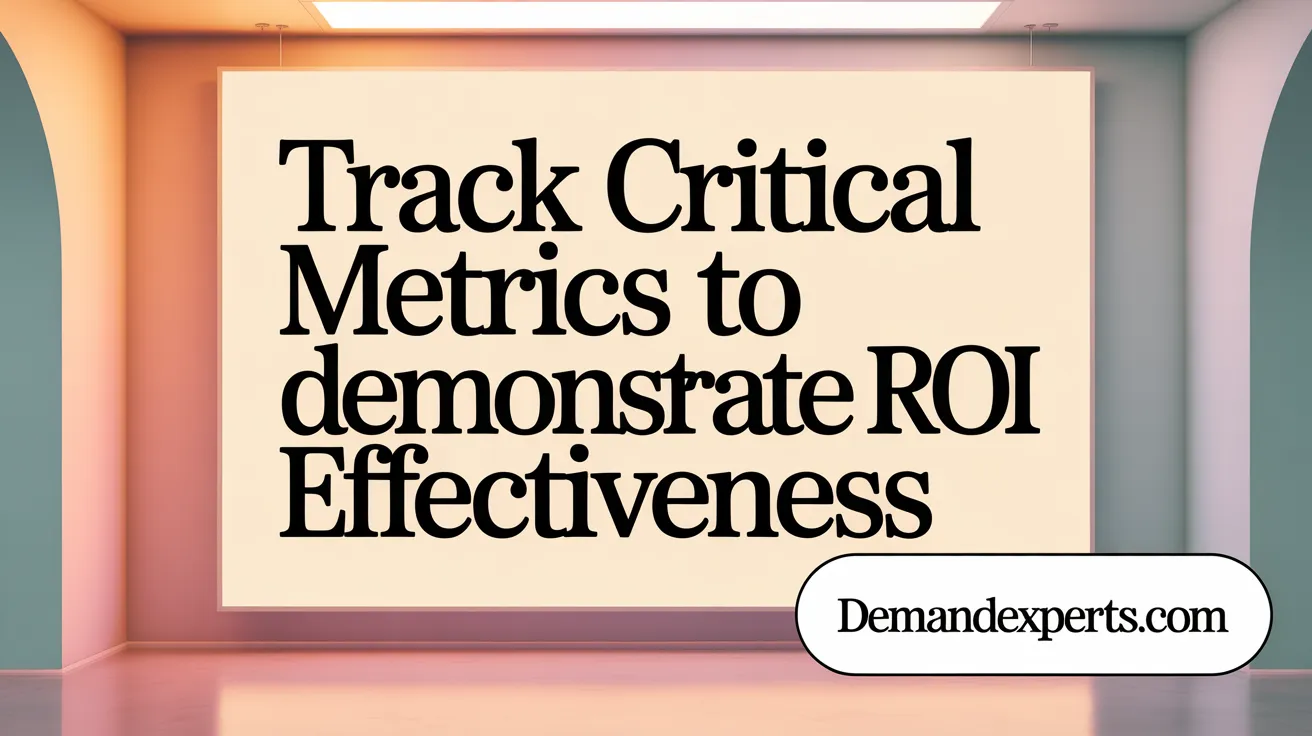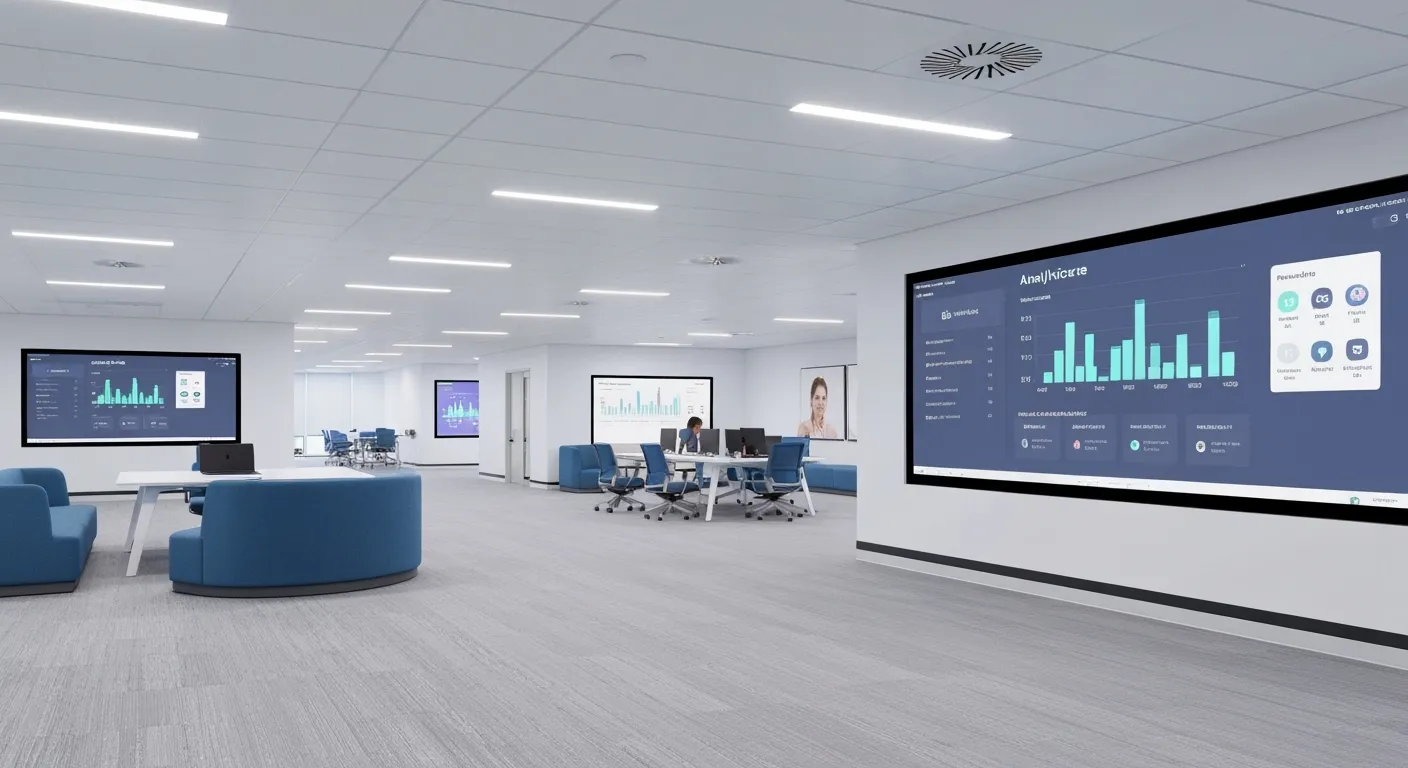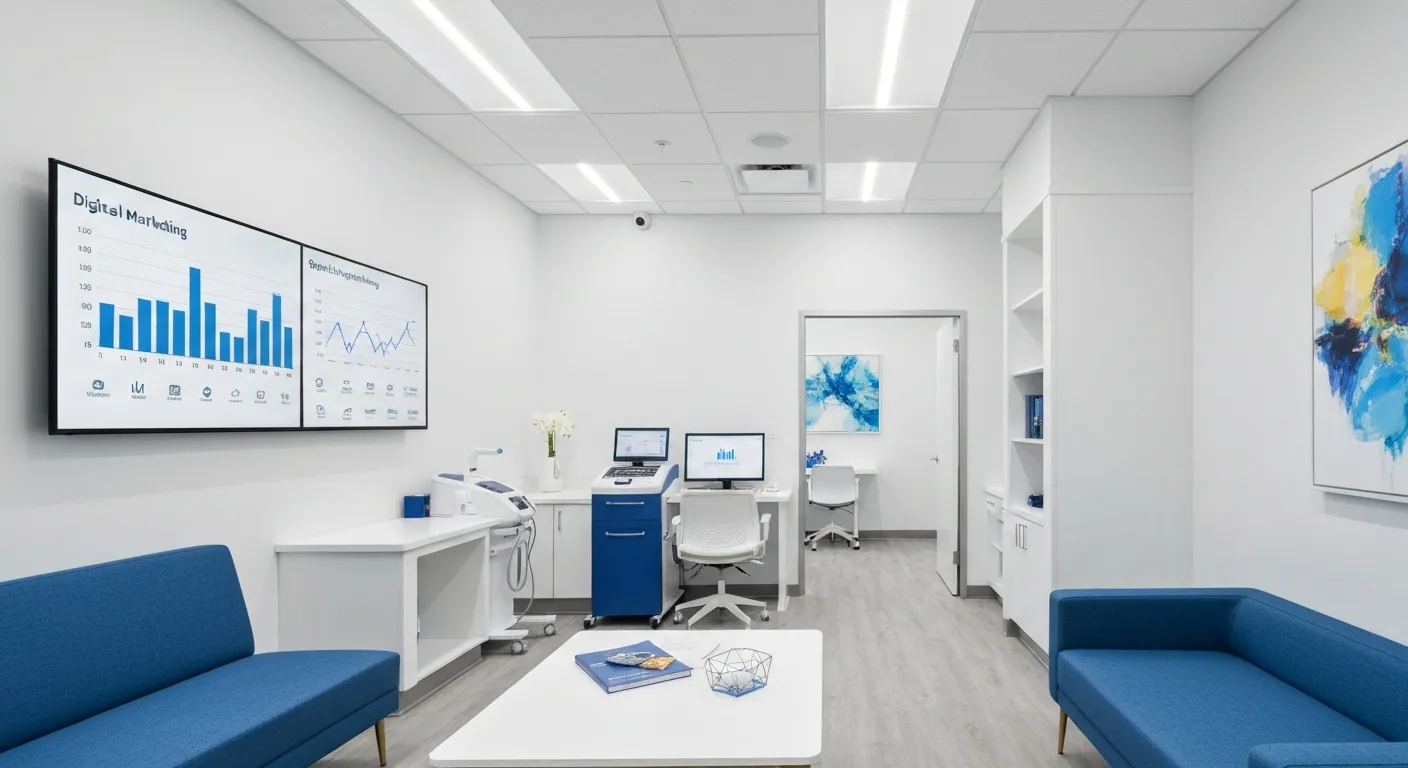The Shift Towards Data-Driven Healthcare Marketing
Healthcare marketing is undergoing a transformation fueled by expansive data acquisition and sophisticated analytics. Organizations are leveraging electronic health records (EHRs), digital behavior metrics, and social media engagement to understand patient needs, optimize campaign effectiveness, and measure return on investment (ROI) more accurately. This article explores the data-driven methods healthcare marketers employ to track and enhance ROI, ensuring marketing budgets deliver measurable value and align closely with patient outcomes and organizational goals.
Foundations of Data-Driven Healthcare Marketing

What kinds of data are essential for effective healthcare marketing?
Healthcare marketing depends on a rich variety of data sources to achieve personalized and effective outreach. Essential data includes electronic health records (EHRs), website traffic analytics, search keyword data, social media engagement metrics, patient surveys, online reviews, and claims data. Each of these data types offers unique insights into patient behaviors, preferences, and needs, enabling marketers to tailor communications to specific audiences. For example, EHRs provide clinical and demographic information, while social media and website analytics reveal engagement patterns and interests (Data-Driven Marketing in Healthcare, Healthcare Marketing Analytics).
How does centralizing data support healthcare marketing?
Centralizing diverse healthcare data into unified platforms empowers marketers to use advanced AI-powered tools and predictive analytics. This integration enables smarter, more targeted marketing strategies by providing a complete view of patient interactions and preferences. AI tools can automate patient engagement, deliver personalized messaging, and optimize campaign timing based on real-time insights. As a result, healthcare organizations improve campaign effectiveness and maximize their return on investment (ROI) (Centralizing Healthcare Data, AI Tools for Healthcare Marketing, Predictive Analytics in Healthcare).
Patient preference for personalized marketing
Patients increasingly expect healthcare communications to be tailored to their unique health needs and circumstances. Traditional marketing methods often fall short by delivering generic messages. Leveraging data from EHRs and digital channels allows marketers to customize recommendations and outreach. Personalized marketing builds trust, increases patient engagement, and fosters long-term relationships (Personalized Healthcare Recommendations, Personalized healthcare marketing approaches).
Data types supporting marketing efforts
Healthcare marketing uses a combination of claims data, patient surveys, and social media engagement information. Claims data helps identify service usage patterns and payer mix, which influence reimbursement rates and profitability. Patient surveys capture satisfaction and experience metrics, informing campaign refinement. Social media engagement metrics such as likes, shares, and comments indicate content relevance and help shape future messaging strategies (Healthcare Market Intelligence, Healthcare marketing metrics, Social Media Insights in Healthcare Marketing.
Key Metrics to Measure Healthcare Marketing ROI

Which metrics best prove ROI in healthcare marketing?
Healthcare marketing ROI is best demonstrated by a set of financial and engagement metrics. Important measures include Cost Per Acquisition (CPA), which calculates the expense of acquiring each new patient relative to the total marketing spend. Conversion rate reflects the percentage of targeted patients who take desired actions such as scheduling appointments or submitting forms. Additionally, audience quality assesses how effectively campaigns reach likely patients, while tracking the number of leads and their stage in the sales funnel helps track marketing effectiveness.
Consumer engagement metrics—like clicks, shares, comments, and calls—offer insight into patient responsiveness and campaign resonance. Moreover, the contribution margin metric, which subtracts variable costs from revenues, evaluates the profitability of marketing efforts and guides financial resource allocation.
How does payer mix influence ROI measurement?
The payer mix significantly impacts the ROI of healthcare marketing. Patients with commercial insurance typically result in higher reimbursement rates compared to those covered by Medicare or Medicaid. Since reimbursement levels affect overall profitability, marketing campaigns targeted to patient groups with a favorable payer mix are likely to achieve better ROI. Therefore, understanding and incorporating payer mix data is critical when measuring campaign effectiveness and planning budgets.
Why is multi-channel analysis and KPI dashboards important?
Healthcare marketing involves complex customer journeys across multiple channels including digital, social media, and offline interactions. Multi-channel analysis ensures marketing efforts are evaluated holistically rather than in isolation. This approach uncovers how different platforms contribute to lead generation and patient acquisition.
Detailed KPI dashboards empower marketers to monitor metrics like CPA, conversion rates, engagement levels, and contribution margins in real-time. These dashboards facilitate quick decision-making, ongoing campaign optimization, and clearer attribution of performance to specific initiatives. By continuously measuring and analyzing these KPIs, organizations enhance transparency and justify marketing investments more effectively.
Advanced Attribution and Analytics Techniques

What are the limitations of traditional ROI measurement methods in healthcare marketing?
Traditional ROI measurement methods in healthcare marketing often rely on vanity metrics such as clicks, impressions, and single-touch attribution models. These approaches fail to accurately reflect the patient journey, which is typically nonlinear and involves multiple interactions across various marketing channels over an extended period. As a result, these traditional methods underestimate the true influence of marketing efforts and lead to misallocation of marketing budgets and resources.
How do advanced analytics improve ROI tracking?
Advanced analytics improve ROI tracking by employing multi-touch attribution models that capture the full spectrum of patient interactions with healthcare marketing campaigns. These models assign credit to all relevant touchpoints rather than just the first or last interaction, giving a comprehensive view of what drives patient engagement and conversions.
AI and automation play a pivotal role by identifying the most impactful touchpoints and enabling real-time strategy adjustments. This allows healthcare marketers to refine campaigns dynamically, improving targeting, personalization, and efficiency.
Multi-Touch Attribution Models Capturing Full Patient Journey
Multi-touch attribution accounts for the complexity of healthcare patient journeys by crediting each interaction a patient has across digital channels, social platforms, websites, and offline encounters. This holistic tracking allows marketers to understand how various campaign elements work together to influence patient decisions.
Avoiding Vanity Metrics and Single-Touch Models
Vanity metrics, such as raw clicks and impressions, provide limited insight into whether marketing efforts result in meaningful patient actions like appointment bookings. Likewise, single-touch models simplify attribution to one point, ignoring the comprehensive patient journey. Avoiding these pitfalls leads to more accurate ROI measurement and better strategic decisions.
Role of AI and Automation in Identifying Impactful Touchpoints
Artificial intelligence and marketing automation analyze vast data sets to pinpoint high-value marketing interactions. They enable closed-loop reporting by connecting patient acquisition data from electronic health records (EHR) and customer relationship management (CRM) systems to marketing campaign performance.
Closed-Loop Reporting and Unified Patient Profiles for Precise ROI Tracking
A closed-loop system integrates marketing data with patient action data, such as scheduled and attended appointments, creating unified patient profiles. This comprehensive data linkage ensures precise tracking of campaign impact on actual patient behavior, facilitating better cost-per-acquisition calculations and ROI validation.
Together, these advanced attribution and analytics techniques elevate healthcare marketing sophistication, enabling resource optimization and stronger alignment with organizational goals.
Integrating Marketing and Clinical Data for True ROI Visibility

How does integration of clinical and marketing data enhance ROI measurement?
The integration of clinical data from electronic health records (EHRs), such as appointment bookings and attendance, with marketing data significantly improves the accuracy and completeness of ROI measurement in healthcare marketing. By combining these datasets, healthcare organizations obtain a holistic picture of patient acquisition costs and conversion pathways.
This integrated view enables marketing teams to precisely calculate the Customer Acquisition Cost (CAC), moving beyond traditional metrics that only track clicks or form submissions. Access to appointment data concretely links marketing efforts to actual patient actions, allowing for better assessment of campaign effectiveness.
Such integration supports more informed budgeting decisions as healthcare marketers can identify which campaigns and channels yield real patient engagement and revenue. It fosters resource allocation aligned with service line goals, improving marketing efficiency and overall return on investment.
What role do privacy platforms play in data integration?
Privacy platforms are essential in healthcare marketing data integration because they ensure compliance with stringent regulations like HIPAA, which protect sensitive patient information. These platforms securely collect, manage, and activate patient data from disparate systems such as EHRs and marketing automation tools.
By building secure data bridges, privacy platforms enable marketers to access critical metrics like appointments booked and attended without directly exposing protected health information. This approach maintains patient confidentiality while unlocking downstream marketing measurement capabilities.
Examples include Health Privacy Platforms that centralize visitor data collection and connect with EHR data, facilitating accurate CAC calculations. These platforms help organizations overcome data fragmentation challenges while upholding legal and ethical standards.
Enhancing budgeting and strategic decision-making with integrated datasets
The availability of integrated clinical and marketing data transforms healthcare marketing budgeting and strategy. Marketers gain detailed insights into which campaigns effectively convert leads into patients, allowing precise budget allocation toward high-ROI initiatives.
Integration enables longitudinal tracking of patient journeys from initial touchpoints to service utilization. Healthcare organizations can identify underperforming channels or service lines and reallocate spend accordingly.
Furthermore, integrated datasets promote informed conversations with C-suite and finance teams by providing clear evidence of marketing effectiveness based on actual patient acquisition and retention metrics. This strengthens justification for marketing investments and supports strategic growth plans.
Real-Time Campaign Monitoring and Adaptive Marketing Strategies

How can real-time data improve healthcare marketing ROI?
Real-time analytics empower marketers to swiftly assess campaign performance through metrics like website traffic analysis, social media engagement metrics, and user behaviors. By tracking these metrics continuously, healthcare organizations can promptly identify areas underperforming and adjust tactics to optimize results. For instance, automated follow-ups for high-intent patient actions —such as multiple page views or content downloads—enable efficient lead nurturing by targeting warm prospects immediately, reducing drop-offs and boosting conversion rates.
Why is behavioral segmentation crucial for campaign success?
Behavioral segmentation in healthcare marketing leverages detailed patient interaction data, including visit frequency, engagement channels, and service utilization patterns, to customize messages effectively. This segmentation aligns marketing efforts with the patient’s current stage in their care journey, enhancing message relevancy and increasing the likelihood of conversion. Predictive analytics for patient conversion further refine this approach by forecasting patients’ future needs, allowing healthcare marketers to proactively engage patients with personalized content, ultimately maximizing ROI.
Utilizing website analytics, social media engagement, and A/B testing
Website analytics provide insights into visitor behavior, helping identify drop-off points and optimize user experience. Social media engagement metrics such as likes, shares, and comments offer a gauge of content relevance and patient interaction. Running A/B testing for campaign optimization on campaign elements allows marketers to empirically determine the most effective messaging and digital assets, continuously improving campaign impact.
Role of dashboards and frequent reporting in campaign optimization
Real-time marketing dashboards for optimization present real-time data visually, enabling quick performance assessments and data-driven decision-making. Frequent reporting—weekly or monthly—allows teams to monitor KPIs closely, facilitate timely interventions, and reallocate budgets to high-performing channels. This ongoing scrutiny ensures campaigns remain aligned with goals and deliver measurable ROI in healthcare marketing.
Automated follow-ups triggered by patient behavior for lead nurturing
Triggered automation based on patient actions, such as repeated visits or resource downloads, fosters timely and personalized communication. These automated touchpoints maintain patient engagement without manual effort, nurturing prospects through the funnel efficiently and increasing conversion rates.
Behavioral segmentation and predictive analytics to tailor messaging
Detailed segmentation informed by behavioral data allows targeting patients based on demographics, medical history, and online interactions. Predictive models anticipate patient needs and likely future behaviors, enabling healthcare providers to design campaigns that resonate personally, improving engagement and campaign effectiveness through predictive analytics in healthcare marketing.
Leveraging Technology Tools for Comprehensive ROI Assessment
What technology tools are vital for tracking healthcare marketing ROI?
Several key technology tools are essential for accurate ROI tracking in healthcare marketing. Call and form tracking platforms like CallRail and Liine enable marketers to identify which campaigns generate patient inquiries by tracking phone calls and online form submissions. Online scheduling tools, such as NexHealth, integrate appointment bookings into the analytics ecosystem, connecting marketing efforts directly with patient actions. Customer Data Platforms (CDPs) like Rudderstack and Freshpaint centralize visitor data across channels to create unified patient profiles, enabling multi-touch attribution models for more precise ROI measurement. Marketing automation and CRM solutions (e.g., HubSpot, Salesforce) streamline outreach, personalize communications, and provide robust data collection for campaign performance assessment. Finally, analytics dashboards and reporting tools offer real-time insights, allowing marketers to optimize campaigns promptly and measure effectiveness quantitatively (Healthcare Marketing Data Analytics).
How do these tools support HIPAA compliance in marketing analytics?
Healthcare marketing tools address stringent HIPAA requirements by utilizing data anonymization techniques, such as de-identification and hashing, protecting patient identities. They incorporate secure data handling protocols, ensuring sensitive information is neither exposed nor stored improperly during analysis. This compliance enables healthcare marketers to attribute patient actions—like online form completion or appointment booking—to specific campaigns without accessing protected health information (PHI) (HIPAA and Privacy in Healthcare Marketing). Additionally, platforms designed for healthcare marketing integrate privacy frameworks that handle consent management and audit trails, maintaining trust and regulatory adherence (Healthcare Privacy Platforms). These secure architectures facilitate accurate, compliant ROI tracking essential for healthcare organizations to justify investments while safeguarding patient privacy.
Case Studies and Industry Insights Demonstrating ROI Impact
What examples demonstrate effective data-driven healthcare marketing ROI?
Healthcare leaders like Cleveland Clinic and Mayo Clinic have significantly improved their marketing ROI by leveraging digital marketing analytics. By carefully tracking conversions, website analytics, and utilizing tools like Salesforce and HubSpot, these institutions optimized their campaigns, concentrating efforts on channels that drive high patient engagement and acquisition.
Pharmaceutical giants Pfizer and AstraZeneca offer notable examples of data-driven campaign success. Pfizer's 'Get Old' campaign focusing on healthy aging increased brand engagement among older adults by 40%. AstraZeneca's targeted digital advertising for diabetes achieved a 25% higher click-through rate and a 15% boost in overall engagement. These precise targeting efforts highlight the power of data in increasing patient interaction.
Mount Sinai further demonstrated the impact of data-driven marketing by reporting a 35% increase in patient inquiries. These cases collectively emphasize how data analytics can enhance patient retention and acquisition through tailored messaging and optimized digital outreach.
What future trends are shaping ROI measurement in healthcare marketing?
The future of healthcare marketing ROI measurement is increasingly influenced by innovative technologies. Artificial intelligence (AI) and machine learning are at the forefront, enabling predictive patient behavior models that allow marketers to anticipate needs and personalize campaigns more effectively.
Blockchain technology is gaining attention for securing patient data and ensuring compliance with privacy regulations while enabling rich data analytics. Meanwhile, telehealth continues to expand, presenting new channels for marketing and patient engagement.
Video content, especially personalized and testimonial videos, is driving higher engagement rates. Studies show personalized videos can boost engagement by over 50%, leading to improved appointment bookings and retention.
In addition, advanced multi-channel attribution models provide a comprehensive understanding of the patient journey, allowing marketers to allocate resources efficiently and demonstrate precise ROI. These trends are collectively transforming healthcare marketing, making ROI measurement more accurate, actionable, and aligned with organizational goals.
The Future of ROI Tracking in Healthcare Marketing
As healthcare marketing becomes increasingly sophisticated, integrating diverse data sources with advanced analytics technologies is essential to accurately measure and maximize ROI. Multi-touch attribution, real-time monitoring, secure data integration, and AI-driven insights enable healthcare marketers to tailor campaigns, optimize budgets, and demonstrate tangible business and clinical outcomes. Embracing these data-driven methods not only justifies marketing investments but also enhances patient engagement and care delivery. Forward-looking healthcare organizations that adopt these strategies will lead the way in delivering impactful, measurable marketing performance.
The Shift Towards Data-Driven Healthcare Marketing
Healthcare marketing is undergoing a transformation fueled by expansive data acquisition and sophisticated analytics. Organizations are leveraging electronic health records (EHRs), digital behavior metrics, and social media engagement to understand patient needs, optimize campaign effectiveness, and measure return on investment (ROI) more accurately. This article explores the data-driven methods healthcare marketers employ to track and enhance ROI, ensuring marketing budgets deliver measurable value and align closely with patient outcomes and organizational goals.
Foundations of Data-Driven Healthcare Marketing

What kinds of data are essential for effective healthcare marketing?
Healthcare marketing depends on a rich variety of data sources to achieve personalized and effective outreach. Essential data includes electronic health records (EHRs), website traffic analytics, search keyword data, social media engagement metrics, patient surveys, online reviews, and claims data. Each of these data types offers unique insights into patient behaviors, preferences, and needs, enabling marketers to tailor communications to specific audiences. For example, EHRs provide clinical and demographic information, while social media and website analytics reveal engagement patterns and interests (Data-Driven Marketing in Healthcare, Healthcare Marketing Analytics).
How does centralizing data support healthcare marketing?
Centralizing diverse healthcare data into unified platforms empowers marketers to use advanced AI-powered tools and predictive analytics. This integration enables smarter, more targeted marketing strategies by providing a complete view of patient interactions and preferences. AI tools can automate patient engagement, deliver personalized messaging, and optimize campaign timing based on real-time insights. As a result, healthcare organizations improve campaign effectiveness and maximize their return on investment (ROI) (Centralizing Healthcare Data, AI Tools for Healthcare Marketing, Predictive Analytics in Healthcare).
Patient preference for personalized marketing
Patients increasingly expect healthcare communications to be tailored to their unique health needs and circumstances. Traditional marketing methods often fall short by delivering generic messages. Leveraging data from EHRs and digital channels allows marketers to customize recommendations and outreach. Personalized marketing builds trust, increases patient engagement, and fosters long-term relationships (Personalized Healthcare Recommendations, Personalized healthcare marketing approaches).
Data types supporting marketing efforts
Healthcare marketing uses a combination of claims data, patient surveys, and social media engagement information. Claims data helps identify service usage patterns and payer mix, which influence reimbursement rates and profitability. Patient surveys capture satisfaction and experience metrics, informing campaign refinement. Social media engagement metrics such as likes, shares, and comments indicate content relevance and help shape future messaging strategies (Healthcare Market Intelligence, Healthcare marketing metrics, Social Media Insights in Healthcare Marketing.
Key Metrics to Measure Healthcare Marketing ROI

Which metrics best prove ROI in healthcare marketing?
Healthcare marketing ROI is best demonstrated by a set of financial and engagement metrics. Important measures include Cost Per Acquisition (CPA), which calculates the expense of acquiring each new patient relative to the total marketing spend. Conversion rate reflects the percentage of targeted patients who take desired actions such as scheduling appointments or submitting forms. Additionally, audience quality assesses how effectively campaigns reach likely patients, while tracking the number of leads and their stage in the sales funnel helps track marketing effectiveness.
Consumer engagement metrics—like clicks, shares, comments, and calls—offer insight into patient responsiveness and campaign resonance. Moreover, the contribution margin metric, which subtracts variable costs from revenues, evaluates the profitability of marketing efforts and guides financial resource allocation.
How does payer mix influence ROI measurement?
The payer mix significantly impacts the ROI of healthcare marketing. Patients with commercial insurance typically result in higher reimbursement rates compared to those covered by Medicare or Medicaid. Since reimbursement levels affect overall profitability, marketing campaigns targeted to patient groups with a favorable payer mix are likely to achieve better ROI. Therefore, understanding and incorporating payer mix data is critical when measuring campaign effectiveness and planning budgets.
Why is multi-channel analysis and KPI dashboards important?
Healthcare marketing involves complex customer journeys across multiple channels including digital, social media, and offline interactions. Multi-channel analysis ensures marketing efforts are evaluated holistically rather than in isolation. This approach uncovers how different platforms contribute to lead generation and patient acquisition.
Detailed KPI dashboards empower marketers to monitor metrics like CPA, conversion rates, engagement levels, and contribution margins in real-time. These dashboards facilitate quick decision-making, ongoing campaign optimization, and clearer attribution of performance to specific initiatives. By continuously measuring and analyzing these KPIs, organizations enhance transparency and justify marketing investments more effectively.
Advanced Attribution and Analytics Techniques

What are the limitations of traditional ROI measurement methods in healthcare marketing?
Traditional ROI measurement methods in healthcare marketing often rely on vanity metrics such as clicks, impressions, and single-touch attribution models. These approaches fail to accurately reflect the patient journey, which is typically nonlinear and involves multiple interactions across various marketing channels over an extended period. As a result, these traditional methods underestimate the true influence of marketing efforts and lead to misallocation of marketing budgets and resources.
How do advanced analytics improve ROI tracking?
Advanced analytics improve ROI tracking by employing multi-touch attribution models that capture the full spectrum of patient interactions with healthcare marketing campaigns. These models assign credit to all relevant touchpoints rather than just the first or last interaction, giving a comprehensive view of what drives patient engagement and conversions.
AI and automation play a pivotal role by identifying the most impactful touchpoints and enabling real-time strategy adjustments. This allows healthcare marketers to refine campaigns dynamically, improving targeting, personalization, and efficiency.
Multi-Touch Attribution Models Capturing Full Patient Journey
Multi-touch attribution accounts for the complexity of healthcare patient journeys by crediting each interaction a patient has across digital channels, social platforms, websites, and offline encounters. This holistic tracking allows marketers to understand how various campaign elements work together to influence patient decisions.
Avoiding Vanity Metrics and Single-Touch Models
Vanity metrics, such as raw clicks and impressions, provide limited insight into whether marketing efforts result in meaningful patient actions like appointment bookings. Likewise, single-touch models simplify attribution to one point, ignoring the comprehensive patient journey. Avoiding these pitfalls leads to more accurate ROI measurement and better strategic decisions.
Role of AI and Automation in Identifying Impactful Touchpoints
Artificial intelligence and marketing automation analyze vast data sets to pinpoint high-value marketing interactions. They enable closed-loop reporting by connecting patient acquisition data from electronic health records (EHR) and customer relationship management (CRM) systems to marketing campaign performance.
Closed-Loop Reporting and Unified Patient Profiles for Precise ROI Tracking
A closed-loop system integrates marketing data with patient action data, such as scheduled and attended appointments, creating unified patient profiles. This comprehensive data linkage ensures precise tracking of campaign impact on actual patient behavior, facilitating better cost-per-acquisition calculations and ROI validation.
Together, these advanced attribution and analytics techniques elevate healthcare marketing sophistication, enabling resource optimization and stronger alignment with organizational goals.
Integrating Marketing and Clinical Data for True ROI Visibility

How does integration of clinical and marketing data enhance ROI measurement?
The integration of clinical data from electronic health records (EHRs), such as appointment bookings and attendance, with marketing data significantly improves the accuracy and completeness of ROI measurement in healthcare marketing. By combining these datasets, healthcare organizations obtain a holistic picture of patient acquisition costs and conversion pathways.
This integrated view enables marketing teams to precisely calculate the Customer Acquisition Cost (CAC), moving beyond traditional metrics that only track clicks or form submissions. Access to appointment data concretely links marketing efforts to actual patient actions, allowing for better assessment of campaign effectiveness.
Such integration supports more informed budgeting decisions as healthcare marketers can identify which campaigns and channels yield real patient engagement and revenue. It fosters resource allocation aligned with service line goals, improving marketing efficiency and overall return on investment.
What role do privacy platforms play in data integration?
Privacy platforms are essential in healthcare marketing data integration because they ensure compliance with stringent regulations like HIPAA, which protect sensitive patient information. These platforms securely collect, manage, and activate patient data from disparate systems such as EHRs and marketing automation tools.
By building secure data bridges, privacy platforms enable marketers to access critical metrics like appointments booked and attended without directly exposing protected health information. This approach maintains patient confidentiality while unlocking downstream marketing measurement capabilities.
Examples include Health Privacy Platforms that centralize visitor data collection and connect with EHR data, facilitating accurate CAC calculations. These platforms help organizations overcome data fragmentation challenges while upholding legal and ethical standards.
Enhancing budgeting and strategic decision-making with integrated datasets
The availability of integrated clinical and marketing data transforms healthcare marketing budgeting and strategy. Marketers gain detailed insights into which campaigns effectively convert leads into patients, allowing precise budget allocation toward high-ROI initiatives.
Integration enables longitudinal tracking of patient journeys from initial touchpoints to service utilization. Healthcare organizations can identify underperforming channels or service lines and reallocate spend accordingly.
Furthermore, integrated datasets promote informed conversations with C-suite and finance teams by providing clear evidence of marketing effectiveness based on actual patient acquisition and retention metrics. This strengthens justification for marketing investments and supports strategic growth plans.
Real-Time Campaign Monitoring and Adaptive Marketing Strategies

How can real-time data improve healthcare marketing ROI?
Real-time analytics empower marketers to swiftly assess campaign performance through metrics like website traffic analysis, social media engagement metrics, and user behaviors. By tracking these metrics continuously, healthcare organizations can promptly identify areas underperforming and adjust tactics to optimize results. For instance, automated follow-ups for high-intent patient actions —such as multiple page views or content downloads—enable efficient lead nurturing by targeting warm prospects immediately, reducing drop-offs and boosting conversion rates.
Why is behavioral segmentation crucial for campaign success?
Behavioral segmentation in healthcare marketing leverages detailed patient interaction data, including visit frequency, engagement channels, and service utilization patterns, to customize messages effectively. This segmentation aligns marketing efforts with the patient’s current stage in their care journey, enhancing message relevancy and increasing the likelihood of conversion. Predictive analytics for patient conversion further refine this approach by forecasting patients’ future needs, allowing healthcare marketers to proactively engage patients with personalized content, ultimately maximizing ROI.
Utilizing website analytics, social media engagement, and A/B testing
Website analytics provide insights into visitor behavior, helping identify drop-off points and optimize user experience. Social media engagement metrics such as likes, shares, and comments offer a gauge of content relevance and patient interaction. Running A/B testing for campaign optimization on campaign elements allows marketers to empirically determine the most effective messaging and digital assets, continuously improving campaign impact.
Role of dashboards and frequent reporting in campaign optimization
Real-time marketing dashboards for optimization present real-time data visually, enabling quick performance assessments and data-driven decision-making. Frequent reporting—weekly or monthly—allows teams to monitor KPIs closely, facilitate timely interventions, and reallocate budgets to high-performing channels. This ongoing scrutiny ensures campaigns remain aligned with goals and deliver measurable ROI in healthcare marketing.
Automated follow-ups triggered by patient behavior for lead nurturing
Triggered automation based on patient actions, such as repeated visits or resource downloads, fosters timely and personalized communication. These automated touchpoints maintain patient engagement without manual effort, nurturing prospects through the funnel efficiently and increasing conversion rates.
Behavioral segmentation and predictive analytics to tailor messaging
Detailed segmentation informed by behavioral data allows targeting patients based on demographics, medical history, and online interactions. Predictive models anticipate patient needs and likely future behaviors, enabling healthcare providers to design campaigns that resonate personally, improving engagement and campaign effectiveness through predictive analytics in healthcare marketing.
Leveraging Technology Tools for Comprehensive ROI Assessment
What technology tools are vital for tracking healthcare marketing ROI?
Several key technology tools are essential for accurate ROI tracking in healthcare marketing. Call and form tracking platforms like CallRail and Liine enable marketers to identify which campaigns generate patient inquiries by tracking phone calls and online form submissions. Online scheduling tools, such as NexHealth, integrate appointment bookings into the analytics ecosystem, connecting marketing efforts directly with patient actions. Customer Data Platforms (CDPs) like Rudderstack and Freshpaint centralize visitor data across channels to create unified patient profiles, enabling multi-touch attribution models for more precise ROI measurement. Marketing automation and CRM solutions (e.g., HubSpot, Salesforce) streamline outreach, personalize communications, and provide robust data collection for campaign performance assessment. Finally, analytics dashboards and reporting tools offer real-time insights, allowing marketers to optimize campaigns promptly and measure effectiveness quantitatively (Healthcare Marketing Data Analytics).
How do these tools support HIPAA compliance in marketing analytics?
Healthcare marketing tools address stringent HIPAA requirements by utilizing data anonymization techniques, such as de-identification and hashing, protecting patient identities. They incorporate secure data handling protocols, ensuring sensitive information is neither exposed nor stored improperly during analysis. This compliance enables healthcare marketers to attribute patient actions—like online form completion or appointment booking—to specific campaigns without accessing protected health information (PHI) (HIPAA and Privacy in Healthcare Marketing). Additionally, platforms designed for healthcare marketing integrate privacy frameworks that handle consent management and audit trails, maintaining trust and regulatory adherence (Healthcare Privacy Platforms). These secure architectures facilitate accurate, compliant ROI tracking essential for healthcare organizations to justify investments while safeguarding patient privacy.
Case Studies and Industry Insights Demonstrating ROI Impact
What examples demonstrate effective data-driven healthcare marketing ROI?
Healthcare leaders like Cleveland Clinic and Mayo Clinic have significantly improved their marketing ROI by leveraging digital marketing analytics. By carefully tracking conversions, website analytics, and utilizing tools like Salesforce and HubSpot, these institutions optimized their campaigns, concentrating efforts on channels that drive high patient engagement and acquisition.
Pharmaceutical giants Pfizer and AstraZeneca offer notable examples of data-driven campaign success. Pfizer's 'Get Old' campaign focusing on healthy aging increased brand engagement among older adults by 40%. AstraZeneca's targeted digital advertising for diabetes achieved a 25% higher click-through rate and a 15% boost in overall engagement. These precise targeting efforts highlight the power of data in increasing patient interaction.
Mount Sinai further demonstrated the impact of data-driven marketing by reporting a 35% increase in patient inquiries. These cases collectively emphasize how data analytics can enhance patient retention and acquisition through tailored messaging and optimized digital outreach.
What future trends are shaping ROI measurement in healthcare marketing?
The future of healthcare marketing ROI measurement is increasingly influenced by innovative technologies. Artificial intelligence (AI) and machine learning are at the forefront, enabling predictive patient behavior models that allow marketers to anticipate needs and personalize campaigns more effectively.
Blockchain technology is gaining attention for securing patient data and ensuring compliance with privacy regulations while enabling rich data analytics. Meanwhile, telehealth continues to expand, presenting new channels for marketing and patient engagement.
Video content, especially personalized and testimonial videos, is driving higher engagement rates. Studies show personalized videos can boost engagement by over 50%, leading to improved appointment bookings and retention.
In addition, advanced multi-channel attribution models provide a comprehensive understanding of the patient journey, allowing marketers to allocate resources efficiently and demonstrate precise ROI. These trends are collectively transforming healthcare marketing, making ROI measurement more accurate, actionable, and aligned with organizational goals.
The Future of ROI Tracking in Healthcare Marketing
As healthcare marketing becomes increasingly sophisticated, integrating diverse data sources with advanced analytics technologies is essential to accurately measure and maximize ROI. Multi-touch attribution, real-time monitoring, secure data integration, and AI-driven insights enable healthcare marketers to tailor campaigns, optimize budgets, and demonstrate tangible business and clinical outcomes. Embracing these data-driven methods not only justifies marketing investments but also enhances patient engagement and care delivery. Forward-looking healthcare organizations that adopt these strategies will lead the way in delivering impactful, measurable marketing performance.






